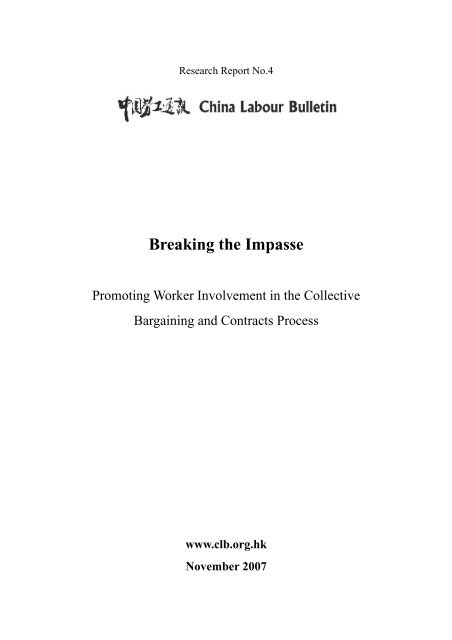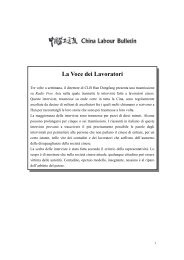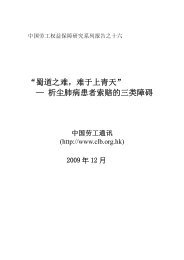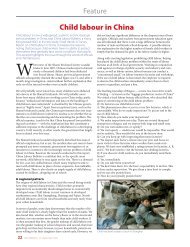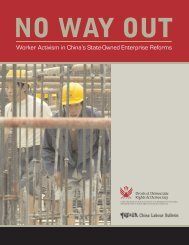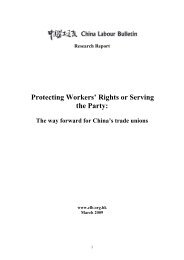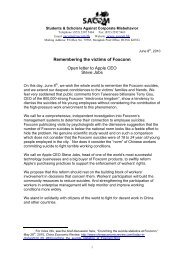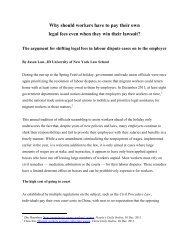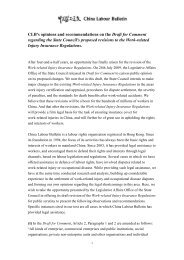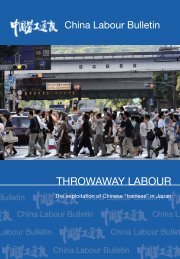here - China Labour Bulletin
here - China Labour Bulletin
here - China Labour Bulletin
Create successful ePaper yourself
Turn your PDF publications into a flip-book with our unique Google optimized e-Paper software.
Research Report No.4<br />
Breaking the Impasse<br />
Promoting Worker Involvement in the Collective<br />
Bargaining and Contracts Process<br />
www.clb.org.hk<br />
November 2007
Introduction.................................................................................................2<br />
I. Laws and policies on the “equal consultation and collective<br />
contracts” system ........................................................................................3<br />
II. Promoting the collective contracts system.............................................5<br />
III. The collective consultation process and the various types of collective<br />
contracts ......................................................................................................7<br />
1. The collective consultation process ....................................................................8<br />
2. The various types of collective contracts............................................................9<br />
IV. The pressing need for collective contracts as a means of reducing<br />
tensions between labour and management ...............................................11<br />
V. Corporate social responsibility and collective contracts .....................14<br />
Conclusion ................................................................................................16<br />
Appendix. The development of the collective contracts system in<br />
<strong>China</strong>… .....................................................................................................18<br />
A list of CLB's research reports................................................................20<br />
1
Introduction<br />
Collective contracts, directly negotiated between representatives of labour and<br />
management, via a process of collective bargaining, are a well-established and<br />
globally recognized means of addressing workers’ demands and ensuring healthy<br />
labour relations. The collective contract system is a cooperative and consensual<br />
mechanism that can help improve working conditions, as well as communication and<br />
understanding between labour and management.<br />
Such a system is urgently needed in <strong>China</strong> today. Violations of workers’ rights are<br />
widespread and increasingly commonplace, and over the last decade t<strong>here</strong> has been a<br />
commensurate rise in the number of workers’ protests, to the extent that labour<br />
disputes are now the single most significant cause of social unrest in the country.<br />
<strong>China</strong> <strong>Labour</strong> <strong>Bulletin</strong> believes the collective contract system, if implemented<br />
correctly with genuine workers’ representation, can act as a powerful tool to improve<br />
workers’ lives and reduce the evident tensions between labour and management in<br />
<strong>China</strong> today. Indeed, the new <strong>Labour</strong> Contract Law, which comes into effect on 1<br />
January, although limited in scope, should provide a favourable environment and<br />
stimulus to the future development of collective contracts.<br />
Collective contracts were used in the early days of the People’s Republic of<br />
<strong>China</strong> (PRC), but they gradually disappeared with the establishment of state-owned<br />
enterprises (SOEs) in the late 1950s. Collective contracts were deemed unnecessary in<br />
SOEs because the Communist Party controlled All-<strong>China</strong> Federation of Trade Unions<br />
(ACFTU) acted as a “bridge” between workers and management that could in theory<br />
mediate any disputes. In reality, the ACFTU simply relayed management dictates to<br />
the workers.<br />
With the introduction of economic reforms in the 1980s, and the growth of the<br />
private sector, the ACFTU’s previously solid enterprise-level powerbase began to<br />
erode. By the early 1990s, the ACFTU was a shadow of its former self, and its leaders<br />
sought to use the collective contract provisions in the PRC’s Trade Union Law (1992)<br />
and <strong>Labour</strong> Law (1994) as a means of regaining some of the prestige and influence<br />
the union had lost. Both laws gave trade unions the right to engage in collective<br />
consultations with management, and in the mid-1990s the government, in conjunction<br />
with the ACFTU, launched a major drive to implement collective contracts in the SOE<br />
sector. At the turn of the century, this drive was extended to the rapidly growing<br />
private sector as well. The collective contract system has been in place for over a<br />
decade now, but, because of the continued lack of genuine collective bargaining,<br />
collective contracts have so far failed to make a significant impact on<br />
labour-management relations in <strong>China</strong>.<br />
<strong>China</strong>’s collective contract system is more formally known as the “equal<br />
2
consultation and collective contract system.” However, the term “equal<br />
consultation” should not be confused with “collective bargaining” as it is<br />
internationally understood. Because of the lack of elected workers’ representatives<br />
and the equivocal nature of the ACFTU as both an agency of government and the<br />
designated representative of labour, “equal consultation” does not emphasize a<br />
bargaining process in which labour and management are able to confront each other as<br />
formal equals. Rather it is a process designed, in the parlance of the current<br />
government, to create “harmony” in the workplace, and in a wider sense ensure<br />
“stability” in society as a whole. In recent decades, the latter term in particular has<br />
often been a by-word for repression rather than dialogue.<br />
However, <strong>China</strong>’s existing legislation does at least provide a legal foundation for<br />
genuine collective bargaining, and this report will examine that legal framework, the<br />
extent to which collective contracts have been implemented thus far, the protection<br />
they provide for workers’ rights and the prospects for future development, especially<br />
in the context of the corporate social responsibility (CSR) movement that has gained<br />
considerable momentum among global companies doing business in <strong>China</strong> over the<br />
last decade.<br />
I. Laws and policies on the “equal consultation and collective<br />
contracts” system<br />
Collective contracts became a real possibility in the PRC again with the passage of the<br />
<strong>Labour</strong> Law in July 1994. The law allowed for workers at a particular enterprise to<br />
sign a collective contract or agreement regarding wages, work hours, workplace safety,<br />
benefits, and other issues. And in December that year, the Ministry of <strong>Labour</strong> (now<br />
the Ministry of <strong>Labour</strong> and Social Security) issued its Regulations on Collective<br />
Contracts giving clear guidelines for the implementation of a collective contract<br />
system. The regulations provided a comprehensive and concrete set of rules governing<br />
the collective contract system, consisting of 41 provisions on the signing and review<br />
of collective contracts and dispute handling. Some nine years later, in January 2004,<br />
the Ministry of <strong>Labour</strong> and Social Security issued updated Regulations on Collective<br />
Contracts which included detailed rules on the consultation process and the selection,<br />
responsibilities and rights of workers’ “consultation representatives.” The new<br />
regulations required that both labour and management add specific provisions on the<br />
protection and training of female and juvenile workers to the scope of collective<br />
contracts. Moreover, the new regulations firmly established the concept of a “Specific<br />
Collective Contract,” defined as a specific written agreement between labour and<br />
management covering, for example, wages, the rights of female employees or health<br />
3
and safety issues. (For more information on specific collective contracts, see Section<br />
III. The collective consultation process and the various types of collective contracts).<br />
It is important to note <strong>here</strong> that under Chinese law, the trade union does not<br />
necessarily have to act as the workers’ representative in the negotiation and signing of<br />
an enterprise-level collective contract. The <strong>Labour</strong> Law states:<br />
Collective contracts shall be signed by the trade union representative and the<br />
enterprise; when t<strong>here</strong> is no trade union established for an enterprise, collective<br />
contracts shall be signed by a representative selected by employees and by the<br />
enterprise (Article 33).<br />
And the Regulations on Collective Contracts issued by the Ministry of <strong>Labour</strong><br />
and Social Security stipulates that workers can elect their own representatives:<br />
The collective consultation representative for employees shall be selected by the<br />
union for the work unit. If t<strong>here</strong> is no union, [the representative] shall be<br />
nominated by the workers in the work unit and approved by a majority of the<br />
workers in that work unit” (Article 20).<br />
However the new <strong>Labour</strong> Contract Law, which will go into effect on 1 January<br />
2008 significantly restricts workers’ ability to directly negotiate a collective contract<br />
without union supervision. It states:<br />
Collective contracts shall be signed by the trade union representing the workers<br />
and the enterprise; if t<strong>here</strong> is no union at an employing work unit, a representative<br />
selected by the workers under the guidance of the next-higher level union shall<br />
sign along with the employing work unit” (Article 51). (Emphasis added).<br />
Once a collective contract is signed, according to the Regulations on Collective<br />
Contracts it becomes a written document with the force of law. In November 2000,<br />
the Ministry of <strong>Labour</strong> and Social Security issued the Interim Measures on Collective<br />
Wage Consultations, which maintain that wage negotiations between labour and<br />
management represent a “bilateral specific collective contract.” If labour and<br />
management have already signed a collective contract, then the wage agreement shall<br />
act as an addendum to the collective contract, and shall enjoy equal force under law<br />
(Article 3). These measures further stipulate that wage consultations shall not be<br />
limited to basic wages but shall also cover the wage allocation system, average salary<br />
levels based on seniority, incentives, bonuses, allowances and subsidies, and the<br />
means by which wages will be paid.<br />
Moreover, the majority of provinces have now drafted and promulgated local<br />
laws and regulations providing for the implementation of a collective contract system<br />
4
in their jurisdictions, including 14 provincial laws and regulations that provide for<br />
regional and industry-specific collective contracts. 1<br />
II. Promoting the collective contracts system<br />
In his work report to the ACFTU’s National Congress in October 1993, the union’s<br />
then vice-chairman Zhang Dinghua said: “We must vigorously promote a collective<br />
contract system in which the union represents labour during consultations with<br />
enterprise management on issues related to workers’ interests.” 2<br />
The promulgation of the <strong>Labour</strong> Law in the following year was seen by the<br />
ACFTU as an ideal opportunity to use collective contracts as a means of rebuilding its<br />
image and re-establishing its powerbase in enterprises across <strong>China</strong>. And at its<br />
national committee meeting in December 1994, the promotion of the collective<br />
contract system was for the first time made a major focus of the union’s work. The<br />
meeting stressed: “Thorough implementation of the <strong>Labour</strong> Law is an opportunity and<br />
an opening that will help drive various union projects, promote reform and<br />
construction.” 3<br />
Following this meeting, the promotion of the collective contract system remained<br />
high on the ACFTU’s agenda for the next three years. The union leadership repeatedly<br />
emphasized that the signing of collective contracts was “a right given to unions by<br />
law,” and that “union organizations at all levels must fully exercise this right.” 4 On 17<br />
August 1995, the ACFTU announced its Test Guidelines for Union Participation in<br />
Equal Consultation and Signing of Collective Contracts. In this document, the<br />
ACFTU set out regulations governing the content of collective consultations and<br />
collective contracts, procedures for signing collective contracts, modification,<br />
elimination and termination of collective contracts, and the responsibilities of the<br />
upper levels of the unions. Only two of the 42 articles in the document referred to the<br />
role of government agencies in resolving conflicts arising out of collective contracts<br />
and the approval of such contracts, indicating that the ACFTU was at that time<br />
confident of its own ability to independently promote a collective contract system<br />
1 Li Wei: Can Collective Contracts Become a New Weapon to Protect Worker Rights? The Observer Daily<br />
(online edition), May 23, 2006.<br />
2 Zhang Dinghua: Report before the 12th National People’s Congress, People's Daily, 1 November 1993, section<br />
1.<br />
3 From the ACFTU: Decision on the Thorough Implementation of the <strong>Labour</strong> Law, excerpted from the People’s<br />
Republic of <strong>China</strong> Federation of Unions’ <strong>China</strong> Union Almanac 1995, <strong>China</strong> People’s Publishing House, 1995, pp.<br />
351-357.<br />
4 Wei Jianxing: Remarks at the 70th Anniversary of the Founding of the Chongqing Chinese National Federation<br />
of Unions, excerpted from the <strong>China</strong> Union Almanac, 1995, <strong>China</strong> People’s Publishing House, 1995, pp. 511-514.<br />
Wei Jianxing: Remarks at the Opening Ceremony of the 12 th National Federation of Unions, excerpted from the<br />
<strong>China</strong> Union Almanac, 1996, <strong>China</strong> People’s Publishing House, 1996, pp. 514-522. Zhang Dinghua: Working<br />
Report at the 3 rd session of the 12th National Federation of Unions, excerpted from the <strong>China</strong> Union Almanac,<br />
1996, <strong>China</strong> People’s Publishing House, 1996, pp. 531-538.<br />
5
without input from government labour agencies.<br />
Immediately after the promulgation of the <strong>Labour</strong> Law, the ACFTU and the<br />
Ministry of <strong>Labour</strong> had different priorities. The main focus of the Ministry of<br />
<strong>Labour</strong> was to promote individual labour contracts within enterprises, 5 w<strong>here</strong>as the<br />
ACFTU concentrated on collective contracts, specifically collective contracts in SOEs.<br />
However, because the ACFTU had always been closely bound up with the Communist<br />
Party, union leaders at all levels had to seek permission from their party counterpart<br />
before undertaking their collective contract work. If such permission or support was<br />
not forthcoming, the ACFTU’s progress in independently promoting the collective<br />
contract system could be severely compromised. By the end of 1995, out of the 2.6<br />
million enterprises in <strong>China</strong>, only 48,431 had signed collective contracts, a coverage<br />
rate of just 1.8 percent. 6 Moreover, many local unions felt that the promotion of the<br />
collective consultation system “was not something that can be done simply because<br />
the union desires it; it requires the close cooperation of management at enterprises, the<br />
recognition of government agencies, a high level of support from the departments<br />
undertaking systemic reform, and the support and understanding of the public.” 7 In<br />
some places, local unions set up working groups led by Party officials and composed<br />
of workers and officials to promote the collective contract system in enterprises. In<br />
these working groups, model collective contracts were drafted, and policies were<br />
established to promote the collective consultation process in the local area. 8 At no<br />
point was the concept of genuine collective bargaining introduced, and the whole<br />
process remained a “top-down” system w<strong>here</strong>by collective contracts were essentially<br />
imposed on individual enterprises. And this would eventually become the framework<br />
used by the ACFTU as a whole in its large-scale promotion of the collective contract<br />
system after 1996.<br />
From 1996 onwards, collective contracts were jointly promoted by the ACFTU,<br />
the Ministry of <strong>Labour</strong> and the National Enterprise Association. Although this<br />
grouping appears on the surface to represent a tripartite mechanism, in reality the<br />
ACFTU is too closely linked to both government and management to be considered a<br />
separate, independent entity. The key point to emphasize <strong>here</strong> is that from 1996 the<br />
5 According to Deputy Minister of <strong>Labour</strong> Zhu Jiaping, “Individual labour contracts are fundamental in<br />
establishing a legal basis for labour relations. Collective contracts are based on individual labour contracts and<br />
secondary to them.” See Zhu Jiaping: Speech at Symposium on Adjustment of <strong>Labour</strong> Relations. Excerpted from<br />
Wang Jianxin (ed.), <strong>China</strong> <strong>Labour</strong> Almanac (1995-1996), Beijing: <strong>China</strong> Labor Publishing House, 1996, p. 99.<br />
6 Xiao Zhenbang: Summary of Union Work, 1995, excerpted from the <strong>China</strong> Union Almanac, 1996, <strong>China</strong><br />
People’s Publishing House, 1996, pp. 19-22. Based on First Survey of Basic Units data, t<strong>here</strong> were 2,628,125 legal<br />
entities registered in <strong>China</strong>. See State Bureau of Statistics web site<br />
.<br />
7 Henan Province Federation of Unions Department of Social Guarantees: An Exploration of Establishing<br />
Collective Consultation and Collective Bargaining Systems for Wages and Other Issues at Enterprises, 1994,<br />
unpublished.<br />
8 Henan Province Federation of Unions Department of Social Guarantees: An Exploration of Establishing<br />
Collective Consultation and Collective Bargaining Systems for Wages and Other Issues at Enterprises, 1994,<br />
unpublished.<br />
6
ACFTU considered the promotion of collective contracts to be a joint effort and not<br />
something it could accomplish itself. 9<br />
The initial focus of the collective contract drive in the mid-90s was to establish<br />
comprehensive collective contracts in SOEs. However the initiative coincided with<br />
the government’s massive SOE privatisation programme in which hundreds of<br />
thousands of SOEs were either closed, merged or bought-out, leading to millions of<br />
workers across <strong>China</strong> being made redundant. Nonetheless, by the end of 1997,<br />
collective contracts had been concluded in 236,000 enterprises, 75 percent of which<br />
were state-owned. At the turn of the century the focus of the programme switched to<br />
the private sector, and in particular the use of specific wage contracts as well as<br />
regional and industry specific contracts. For example, in 2006, the ACFTU, the<br />
Ministry of <strong>Labour</strong> and the National Enterprise Association issued the Opinions<br />
Regarding the Work of Developing Regional and Industry-specific Collective<br />
Consultations, which stated that labour agencies at all levels of government, union<br />
organizations and enterprise federations and associations should, “under the<br />
leadership of the local Party committee and government,” re-double their efforts to<br />
establish regional and industry-specific collective consultations. By September 2005,<br />
a total of 754,000 collective contracts had been signed covering 1.378 million<br />
enterprises, and 103.84 million workers, or 58 percent of all enterprise workers in<br />
<strong>China</strong>. Moreover, according to the ACFTU’s 2005 Blue Paper on the Protection of<br />
Workers’ Legal Rights in <strong>China</strong>, 84,000 regional collective contracts had been signed,<br />
as well as 29,000 industry-specific collective contracts.<br />
III. The collective consultation process and the various types of<br />
collective contracts<br />
The <strong>Labour</strong> Law stipulates that individual enterprises should be the main focus of the<br />
collective consultation process. This highly decentralized approach was devised to<br />
some extent out of political considerations, in that it was hoped a decentralized system<br />
would help prevent labour disputes from spreading over a large area or across a<br />
specific industry. However it soon became apparent to the ACFTU that it would be<br />
difficult to unionize hundreds of thousands of small-scale private enterprises spread<br />
over a wide area, each with no union base, a small workforce and high rate of<br />
employee turnover. As a result, the ACFTU, in addition to unionizing individual<br />
enterprises, sought to establish industry-specific or regional union associations in<br />
9 Including On Gradual Implementation of Collective Consultation and the Collective Contract System<br />
(promulgated May 17, 1996); On Further Promotion of Equal Consultation and the Collective Contract System<br />
(November 14, 2001); On Thorough Implementation of ‘Regulations on Collective Contracts’ (May 14, 2004); On<br />
Further Promotion of Collective Consultation between <strong>Labour</strong> and Management (February 22, 2005) and<br />
Opinions on Developing Collective Consultation in Regional Industry, (August 17, 2006).<br />
7
areas with high concentrations of small- and medium-sized private enterprises, and to<br />
promote industry-wide and regional collective contracts. In the 1996 Background On<br />
the Gradual Implementation of Collective Consultation and the Collective Contract<br />
System the ACFTU suggested that “in areas w<strong>here</strong> t<strong>here</strong> are concentrations of<br />
foreign-invested small businesses and private enterprises, industry-specific or regional<br />
union associations can be established to represent the workers in collective<br />
consultation and in signing collective contracts with the enterprises.”<br />
1. The collective consultation process<br />
The Regulations on Collective Contracts contain a chapter devoted to the process<br />
of collective consultation, including procedures for requesting a meeting,<br />
pre-consultation preparation, convening a consultation meeting, and signing a<br />
collective contract. The regulations stipulate that either labour or management may<br />
give a written request for a collective consultation to the other side in writing, and the<br />
other side must respond in writing within 20 days of the receipt of such request. The<br />
representatives of both parties must be aware of and understand the nature of the<br />
meeting prior to the consultation, and employee representatives must canvas the<br />
opinions and suggestions of employees. Both parties are responsible for drafting an<br />
agenda, setting the date, time and location of the meeting.<br />
Collective consultation meetings should be chaired in rotation by the chief<br />
representative of each side, and both parties should seek to reach a consensus through<br />
a process of discussion and consultation. If the representatives of both sides do not<br />
reach a consensus during the meeting, or if some unforeseen problem occurs, after<br />
mutual discussion the consultation may be halted. The time, location and agenda for<br />
the next session will be decided by both parties.<br />
Although t<strong>here</strong> are clear guidelines to the collective consultation process, in<br />
practice consultations have been hampered by local union officials’ lack of experience<br />
and expertise in contract negotiation. Most union representatives have not been<br />
selected by the workers but rather appointed by management. As such they dared<br />
not face-off with management or vigorously defend the rights and interests of the<br />
workers. All too often the collective consultation process involved merely the copying<br />
and signing of sample contracts provided by the local union. With the introduction of<br />
specific wage consultations in 2000, the ineffectiveness of the union representatives<br />
became even more apparent. An obvious solution to this problem would be to have<br />
a genuinely representative and democratically elected union negotiator participate in<br />
the consultation process; however the ACFTU attempted a technical fix by hiring a<br />
new breed of “collective consultation consultants.” These consultants were<br />
government labour officials, union officials and managers who had undergone training<br />
in consultation techniques and had a basic understanding of the legal foundation of the<br />
8
collective contract process. Once their training was complete, they were presented<br />
with an official certificate jointly issued by the local government labour agency and<br />
the union. Their primary responsibility was to act as a facilitator bringing both labour<br />
and management together, train both sides in appropriate consultation techniques,<br />
assist enterprises in drafting collective contracts, and seek to alleviate tensions and<br />
problems that emerged in the course of the collective consultation process. These<br />
consultants have only become commonly used in the last two years and it remains to<br />
be seen if they will have any lasting or beneficial impact on the consultation process.<br />
2. The various types of collective contracts<br />
Comprehensive collective contracts covering a wide range of work-related issues<br />
such as wages, hours, health and safety, medical insurance and job security, were the<br />
main type of collective contract in the mid-1990s. However, at the turn of the century<br />
the focus switched to specific collective contracts, primarily wage contracts, as well<br />
as regional and industry specific contracts. This change of emphasis suited both<br />
labour and management because they allowed both sides to reach an agreement on<br />
one particular issue and obviated the need for wide-ranging collective contracts which<br />
both labour and management often found too difficult or complex to negotiate<br />
properly. 10<br />
Specific collective wage contracts<br />
In its 1997 Opinions on Collective Wage Consultation for Foreign-Invested<br />
Enterprises, the Ministry of <strong>Labour</strong> urged unions or workers' representatives at<br />
foreign-invested enterprises and representatives of the enterprise to follow national<br />
guidelines on the negotiation and implementation of specific wage contracts. This was<br />
followed up by the ACFTU in April the following year in its Guiding Opinions on<br />
Union Participation in Collective Wage Consultations, and again in 2000 by the<br />
Ministry of <strong>Labour</strong> and Social Security, which issued the Interim Measures on<br />
Collective Wage Consultations, a set of administrative regulations that formally<br />
established the idea that collective wage consultations were applicable to all<br />
enterprises.<br />
According to the ACFTU’s 2005 Blue Paper on the Protection of Workers’<br />
Legal Rights in <strong>China</strong>, a total of 252,000 specific collective wage contracts covering<br />
some 414,000 enterprises and 35.312 million workers had been signed by the end of<br />
September 2005. By the end of 2006, more than 300,000 specific wage contracts had<br />
been signed, covering some 526,000 enterprises (126,000 more than the ACFTU’s<br />
10 Wang Xiangqian: New Developments in <strong>China</strong>'s Collective Contracts System -- An Assessment and Analysis of<br />
the 'Guidelines for Collective Consultation on Wages' <strong>China</strong> <strong>Labour</strong> Net .<br />
9
target) and 37.2 million workers (about 7.8 million fewer than targeted). 11 T<strong>here</strong> were<br />
in addition 19,000 regional wage contracts (see below for details) covering 235,000<br />
enterprises and 8.2 million workers signed by the end of 2006. By the end of 2008, the<br />
ACFTU hopes to have increased wage contract coverage to 60 percent of all workers<br />
in <strong>China</strong>, with more than 50 percent coverage in non-state-owned enterprises; and to<br />
establish a collective wage consultation system in the majority of enterprises that have<br />
a comprehensive collective contract system. 12<br />
Specific collective contracts on the rights of female workers<br />
Specific collective contracts on the protection of the rights of female workers are<br />
primarily used in service enterprises, w<strong>here</strong> t<strong>here</strong> is a high concentration of female<br />
workers. These collective contracts are based on the provisions of the <strong>Labour</strong> Law on<br />
the safety and health and special interests of female workers, as well as the specific<br />
circumstances of the enterprise in question. Contracts generally cover issues such as<br />
maternity leave, gynaecological examinations, and the provision of feminine hygiene<br />
products, but may also include provisions safeguarding women from harassment and<br />
exploitation. By the end of 2006, 119,000 specific contracts including these issues had<br />
been signed, covering 10.5 million mostly female workers at 238,000 enterprises. 13<br />
Specific collective contracts on safety<br />
High-risk industries such as metallurgy, mining and construction have, over the<br />
last few years, promoted specific collective contracts on health and safety. For<br />
example, the union at the Chongqing Coal Group’s Nantong Mining Co signed a<br />
collective contract with management which stipulated management must<br />
comprehensively canvass and take into account the opinions of union and worker<br />
representatives when considering any issues related to worker health and safety. In<br />
addition management should support financially any union-led initiatives on the<br />
health and safety of workers. 14 By the end of 2006, 55,000 specific safety contracts<br />
had been signed across <strong>China</strong>, covering 117,000 enterprises and nearly six million<br />
workers. 15<br />
Specific collective contracts on job training<br />
On 8 August 2002, the union at the Changzhou Gongjiao Group in Jiangsu<br />
signed a specific collective contract with management on employee training. The<br />
11 All-<strong>China</strong> Federation of Trade Unions 2006 Statistical Report on Trade Union Organizing and development.<br />
ACFTU website . These are the ACFTU’s<br />
own statistics and cannot be independently verified.<br />
12 All-<strong>China</strong> Federation of Trade Unions Press Conference No. 1, 2006, ACFTU web site <br />
13 All-<strong>China</strong> Federation of Trade Unions 2006 Statistical Report on Trade Union Organizing and development.<br />
ACFTU website .<br />
14 Li Guo, Wen Liangbing: Chongqing: First specific collective contract on safety signed by labour and<br />
management. Workers’ Daily: reprinted from Xinhuanet , March 17, 2006.<br />
15 All-<strong>China</strong> Federation of Trade Unions 2006 Statistical Report on Trade Union Organizing and development.<br />
ACFTU website .<br />
10
contract stipulated that management has to provide training for workers doing<br />
technical jobs so that they meet national qualification standards before starting work.<br />
During the term of the contract, the company should train a certain number of workers<br />
to specific skill-levels, provide funds for vocational education and reward employees<br />
who obtain college or technical diplomas of their own volition. 16<br />
Since this contract was initiated, several other similar types of contracts have<br />
been signed, including ones on social insurance and work hours. These specific<br />
contracts are generally initiated by local unions, and primarily apply to private<br />
enterprises with very specific work environments and conditions of employment. 17<br />
Regional and industry-specific collective contracts<br />
Since 2000, the government and the ACFTU have jointly promoted regional and<br />
industry-specific collective contracts in areas with a high concentration of small<br />
private enterprises such as industrial parks, small towns and villages. These regional<br />
or industry-specific collective contracts are usually signed by the local or industry<br />
union association and the employing company or the employers’ association. This<br />
form of contract has helped break down the original decentralized structure of the<br />
collective contract system in which the enterprise was the centre of the process.<br />
However, the effectiveness of these new collective contracts has been limited by the<br />
difficulty of taking into account the specific conditions within each enterprise, and<br />
even greater difficulty in satisfying the wide-ranging demands of the workers<br />
concerned. Thus far, the provisions in these contracts have tended to merely copy<br />
provisions in existing labour law, or add some explanatory notes to them, and in<br />
practice they are no more effective in preventing abuses of labour rights by employers<br />
than the law itself.<br />
IV. The pressing need for collective contracts as a means of reducing<br />
tensions between labour and management<br />
The development of <strong>China</strong>’s collective contract system is clearly distinct from that in<br />
western industrialized nations. It has been a top-down process led by the government,<br />
which not only drafted and implemented legislation and regulations but established<br />
the administrative framework w<strong>here</strong>by the process could be carried out. The<br />
ACFTU also adopted a top-down model for implementation, issuing documents, and<br />
setting targets for the number of contracts to be signed within a certain period of time.<br />
And throughout this period, t<strong>here</strong> was no mechanism for genuine collective<br />
bargaining, and the opinions, demands and needs of the workers themselves were<br />
16 Fan Xiaoping: Jiangsu Has Specific Collective Contracts on Job Training, Workers’ Daily, August 14, 2002.<br />
17 Wang Wei, Zhang Zi, Fan Xiaoping: Changzhou Promotes Survey and Consideration of Specific Special<br />
Collective Contracts, Workers’ Daily, November 21, 2002, Sect. 5.<br />
11
generally ignored. As a result, the process of collective contract implementation has<br />
met with numerous obstacles and difficulties on the ground.<br />
The reform and privatization of state-owned enterprises in the 1990s led to the<br />
gradual erosion of the ACFTU’s previously solid enterprise-level powerbase. And the<br />
private enterprises that steadily increased in number during this same period for the<br />
most part did not have union organizations. The union organizations that were set up<br />
by the ACFTU were largely controlled by management. And the collective contracts<br />
that were signed mostly consisted of provisions copied from articles of labour<br />
legislation and regulations; as such they generally did not reflect the needs and<br />
interests of workers in terms of wages and working conditions at individual factories.<br />
Despite the fact that the development of the Chinese collective contract system<br />
occurred in a very particular political and economic environment, and regardless of<br />
the fact that t<strong>here</strong> are still flaws in the collective consultation process and in the<br />
provisions of collective contracts, the process can still be seen as a potentially useful<br />
means of reducing tensions between labour and management. The current state of<br />
labour-management relations in <strong>China</strong> is roughly analogous to that which existed<br />
during the early phases of the Industrial Revolution in Western nations. As the pace of<br />
economic growth increases, the systematic and widespread exploitation of the<br />
workforce increases too. Factory owners are extending working hours, keeping wages<br />
low, docking salaries and using short-term contracts and outsourcing to reduce labour<br />
costs. This has had a hugely negative impact on the rights and interests of Chinese<br />
workers, and relations between labour and management have steadily deteriorated as a<br />
result.<br />
Official statistics show that from 1994 to 2004, the number of collective labour<br />
dispute cases handled by labour dispute arbitration committees (LDACs), as well as<br />
the number of workers involved in such cases, tended to increase substantially year by<br />
year (see Table 1). 18<br />
Table 1 Number of collective labour disputes in <strong>China</strong> and employees involved<br />
Year<br />
Collective labour disputes<br />
(cases)<br />
Workers involved Total workers with labour disputes Workers involved in collective disputes as<br />
percentage of all workers with disputes<br />
1994 1, 482 52, 637 77, 794 67.7<br />
1995 2, 588 77, 340 122, 512 63.1<br />
1996 3, 150 92, 203 189, 120 48.7<br />
1997 4, 109 132, 647 221, 115 60.0<br />
1998 6, 767 251, 268 358, 531 70.1<br />
1999 9, 043 319, 241 473, 957 67.4<br />
18 Data for 1995 - 2004 are from the <strong>China</strong> <strong>Labour</strong> Statistics Almanac for that year, compiled by the National<br />
Bureau of Statistics Office of Census and Social and Employment Statistics, Ministry of <strong>Labour</strong> and Social<br />
Security Office of Planning and Finance, published by the <strong>China</strong> Statistical Publishing House.<br />
Data for 2005-2006 is from the Ministry of <strong>Labour</strong> and Social Security Web Site – Statistical Reports<br />
.<br />
The methods used to compile these statistics were revised in 2005, and this partially explains the significant drop<br />
in the numbers of disputes in 2006.<br />
12
2000 8, 247 259, 445 422, 617 61.4<br />
2001 9, 847 287, 000 467, 000 61.5<br />
2002 11, 024 374, 956 608, 396 61.6<br />
2003 10, 823 514, 573 801, 042 61.6<br />
2004 19, 241 477, 992 764, 981 62.5<br />
2005 19, 000 410, 000 740, 000 55.4<br />
2006 14, 000 350, 000 680, 000 51.5<br />
Moreover, mass protests by workers, such as demonstrations, sit-ins, strikes and<br />
so forth also increased greatly during the same period of time. The 2005 Blue Paper<br />
asserts that that between 1993 and 2003, the number of mass protests in <strong>China</strong> each<br />
year grew from 10,000 to 60,000, with a corresponding increase in the number of<br />
participants each year from 730,000 to 3.07 million. Protests have continued to swell<br />
since then, and Ministry of Public Security statistics from 2004 show that the major<br />
causes of these protests were primarily labour-management disputes, followed by land<br />
disputes, forced evictions and the low level of compensation provided, as well as<br />
issues specifically arising from the privatization of SOEs. 19<br />
<strong>Labour</strong> disputes and protests have not just been confined to domestic enterprises.<br />
Tensions between labour and management are just as prevalent in companies with<br />
overseas investment, notably those from Taiwan and Hong Kong concentrated in<br />
coastal areas of south-eastern <strong>China</strong>. The vast majority of workers in these companies<br />
are migrants from the poorer, less developed rural areas of <strong>China</strong>. And in recent years,<br />
these migrant workers have become increasingly determined to stand up for their<br />
rights and no longer accept substandard working conditions, long hours and low<br />
wages. For example, in February 2005 several thousand employees at Jingyi Industrial<br />
Co Ltd. (a Taiwanese joint-venture company) in Shenzhen took to the streets to<br />
demonstrate against the docking of wages. And in November 2005 more than 3,000<br />
workers at Del Coro Co Ltd. (a wholly-owned Italian company) in Shenzhen went on<br />
strike in protest at the beating of several workers’ representatives who had asked for<br />
an audit of wages by the Italian manager.<br />
These two examples are just the tip of the iceberg. 20 Tensions between labour<br />
and management, in both foreign and domestic firms, are flaring up on a daily basis<br />
and worsening each year. Indeed workers’ protests are no longer simply confined to<br />
individual factories but have become increasingly well organised and spread out to<br />
affect neighbouring and same-sector companies. For example, on 27 July 2005 over<br />
500 employees at Dongzhi Dalian Ltd. went on strike to protest at arbitrary increases<br />
in the speed of the production line and low wages. This action prompted strikes by<br />
workers at other Japanese-invested firms in the Dalian Enterprise Zone such as<br />
Mitsubishi, Toshiba, NEC Electronics, Nissin and Asahi. In total, more than 30,000<br />
19 Chen Lihua: Group Actions Test <strong>China</strong>. The Globe, (Huanqiu) 2005, No. 8.<br />
20 For a detailed discussion of the scale and nature of these protests, see CLB’s research report on the Workers’<br />
Movement 2005-06.<br />
13
workers at a dozen companies went out on strike. And on 4 April 2006 several<br />
thousand workers at Ruifeng Timber Co Ltd. in Shenzhen attempted to present a<br />
petition at the Qilin Mountain Villa w<strong>here</strong> Chinese leaders were staying, protesting at<br />
the company’s compulsory overtime system. Faced with more and more workers’<br />
protests, local governments and unions have begun to reassess their policies and<br />
strategies. Although the government still uses pressure to break up workers’ protests,<br />
it is also now actively considering ways to improve workers’ conditions of<br />
employment in an effort to maintain social stability. And in this regard, CLB believes<br />
genuine collective bargaining and the implementation of properly negotiated<br />
collective contracts could be the most effective means of reducing tensions between<br />
labour and management. This should be the common goal of management,<br />
government, unions and workers alike.<br />
V. Corporate social responsibility and collective contracts<br />
Since the mid-1990s, corporate social responsibility (CSR) has played an increasingly<br />
prominent and influential role in the Chinese workplace, especially in<br />
foreign-invested companies and those enterprises supplying major multinationals and<br />
internationally recognized brands. From 1995 to 2006, at least 8,000 factories in the<br />
coastal regions of <strong>China</strong> agreed to corporate responsibility audits by multinational<br />
companies; those that scored good marks often obtained bigger orders, while some of<br />
those that did not demonstrate sufficient goodwill had their contracts terminated. 21<br />
However the growth of CSR in <strong>China</strong> has yet to significantly improve working<br />
conditions or relations between labour and management as a whole.<br />
The reasons for the ineffectiveness of CSR thus far stem from the fact that it is<br />
seen in <strong>China</strong> as a “virtuous act” on the part of management, designed to eliminate<br />
sweatshops, promote economic and social justice, democracy and equality, but not as<br />
a genuine move to empower workers. CSR can exert significant pressure on a handful<br />
of companies in <strong>China</strong>, spurring suppliers to improve working conditions, but it<br />
cannot systemically affect labour-management relations across the whole country.<br />
CSR codes of conduct are usually based on international human rights and labour<br />
rights standards, and as such provide an invaluable benchmark for acceptable<br />
standards in enterprises across <strong>China</strong>. However, just as in the government and<br />
ACFTU’s collective contract system, it is still essentially a “top-down” approach that<br />
does not necessarily take into account the individual needs and demands of the<br />
workers at the enterprise it is imposed upon. Moreover, corporate codes of conduct<br />
21 Wang Yijie, Liu Peng, Sun Yuping, Wang Yang: Analysis of the Impact of Social Responsibility and<br />
Recognition of SR Standards on the Chinese Government and Responses to SR, <strong>China</strong> Enterprise Confederation,<br />
Global Compact Promotion Office .<br />
14
are not legally enforceable, and the buyer company has to rely on moral authority or<br />
the threat of withdrawing its business in order to enforce its own regulations. The<br />
withdrawal of business or cancelling of an order not only leads to an economic loss<br />
for both parties, it also may lead to the supplier’s employees losing their jobs.<br />
The intention of CSR may be to protect worker interests but only rarely are<br />
workers genuinely involved in the CSR process. Workers at supplier companies<br />
typically know little or nothing of the standards imposed on that company, and even if<br />
the code of conduct stipulates a right to supervision by workers, the workers mostly<br />
have no way of acting to enforce that stipulation. Even if the workers are aware of the<br />
code of conduct, without an effective system of collective worker supervision, any<br />
complaints from individual workers tend to disappear like a stone into the ocean.<br />
International brands that use inspections as a core mechanism to enforce their<br />
codes of conduct put a lot of pressure on their suppliers. Purchasers typically<br />
implement two to three audits of suppliers annually. If one supplier has several<br />
purchasers, it could easily undergo a dozen or more inspections each year. 22 Some<br />
suppliers agree to these audits in order to maintain and win contracts, but simply go<br />
through the motions, providing false information about wage levels and doctored<br />
records of work hours to inspectors, and “guiding” and threatening workers to answer<br />
questions based on the company line. In many cases, factory inspections have become<br />
a game of mutual deception between suppliers and purchasers. Suppliers may make<br />
superficial improvements to working conditions in order to pass these audits, but t<strong>here</strong><br />
is rarely any substantive or long-term benefit accrued by the workers.<br />
Despite the limitations of CSR, in the same way that <strong>China</strong>’s current labour laws<br />
and the ACFTU’s collective contract system provide a potential basis for genuine<br />
collective bargaining, so CSR could in theory help the development of genuine<br />
workers’ rights in <strong>China</strong>. The right of workers to organize unions or undertake<br />
collective bargaining is an important part of many codes of conduct, and the<br />
promotion of a more ambitious and forward-looking variant of CSR in the coastal<br />
region of <strong>China</strong> could potentially provide a significant spur to the development of<br />
union organizing and collective bargaining across the country.<br />
Even the most ardent proponents of CSR would acknowledge that it is<br />
impossible to inspect every factory in the global production system. However if<br />
workers are given the genuine right to supervise management, codes of conduct could<br />
be far more rigorously and effectively enforced. And the best way to ensure effective<br />
supervision is through the negotiation of collective contracts, followed by regular<br />
reviews by the union or workers’ representatives.<br />
Crucially, collective contracts – unlike codes of conduct - are legally binding,<br />
22 Ma Zhijuan: Fed-up with Inspections by Purchasers and Trade Barriers, <strong>China</strong> Economy Weekly, reprinted<br />
from Xinlangnet , 24 October 2005.<br />
15
and they are meant to be promoted and enforced by government labour agencies. The<br />
government can impose sanctions on suppliers that violate the law, and international<br />
brands will have greater confidence that their codes of conduct will actually be<br />
ad<strong>here</strong>d to. Moreover, the workers’ representatives, as the direct signatory of the<br />
collective contract, ultimately can exercise the right to sue the company in the event<br />
of persistent violations of that contract.<br />
In the final analysis, CSR codes of conduct are simply an agreement between<br />
two business partners. The collective contract system, by contrast, puts the workers in<br />
the driver’s seat, and above all refocuses initiatives to advance labour rights in <strong>China</strong><br />
to the critical locus: the legal labour relationship, i.e. that between employers and<br />
workers.<br />
Conclusion<br />
Since the 1990s, <strong>China</strong> has acquired a basic legal, regulatory and administrative<br />
framework for promoting the collective labour contract system. The implementation<br />
of the new <strong>Labour</strong> Contract Law from January 2008 onwards will further strengthen<br />
the legal framework and create a generally beneficial policy environment for<br />
undertaking both individual and collective contract negotiations. The challenge now<br />
for <strong>China</strong>’s labour movement is to give real substance to this process by gradually<br />
introducing collective bargaining into the process.<br />
With the overall level of labour unrest rising steadily around the country<br />
nowadays, t<strong>here</strong> is clearly an urgent need for direct channels of dialogue and dispute<br />
resolution to be opened up between workers and employers. Although the Chinese<br />
government and the official trade union are united in supporting the collective<br />
contracts project, thus far implementation has been of the top-downwards variety,<br />
with such contracts being imposed on the state-owned, private and foreign invested<br />
sectors in a largely pro forma manner. The very limited success and effectiveness of<br />
this project in reducing the number and seriousness of labour disputes in the country<br />
has been a direct result of the lack of any meaningful worker involvement in the<br />
process.<br />
If democratically elected workers’ representatives can be brought into the<br />
collective bargaining process as equal negotiating partners with management, the<br />
resultant labour contracts will more accurately reflect the wishes of both sides,<br />
understanding between workers and management will be enhanced, and the prospects<br />
for normal and healthy industrial relations at the enterprise will rise. In this process,<br />
from being mere bystanders to negotiations between employers and buyers, the<br />
workers would instead be given a direct voice as co-negotiator of the collective<br />
contract, a legally binding document.<br />
16
Of equal importance, this would refocus efforts to protect labour rights on to the<br />
legal labour relationship between employer and worker – the only place w<strong>here</strong> they<br />
can be truly effective. An agreement between employer and buyer, such as a corporate<br />
code of conduct, can exert only a moral force at best; it has no direct bearing or<br />
impact on the legal labour relationship itself, and neither can it be invoked in court.<br />
While such initiatives can certainly play a useful secondary role, in this core sense<br />
they are peripheral to the main task and problem of advancing labour rights in <strong>China</strong>.<br />
The central vehicle for the realization of the country’s labour law standards must, by<br />
definition, be the labour contract – and above all its collective variant.<br />
<strong>China</strong> <strong>Labour</strong> <strong>Bulletin</strong> believes the best way forward now, if the authorities wish<br />
to address the problem of growing industrial unrest and neglect of labour rights at the<br />
fundamental level, is for them to permit and encourage a genuine level of worker<br />
involvement in the collective-contract negotiation process. <strong>China</strong> is currently at the<br />
very beginning stage of this initiative, and much work needs to be done in terms of<br />
education, training and advocacy on the subject of collective bargaining.<br />
However if the opportunity can be seized by all sides – government, labour and<br />
management – the collective contract system could serve as a much-needed catalyst to<br />
improve the lives and working conditions of ordinary workers across <strong>China</strong>. If the<br />
opportunity is missed, the likelihood is that workers will increasingly take matters<br />
into their own hands, and the wave of strikes and protests seen in recent years will<br />
continue to worsen.<br />
If government and management in <strong>China</strong> can, if not embrace, then at least learn to<br />
live with genuine worker participation in the collective “consultation” or bargaining<br />
process, the example of other countries suggests that labour disputes would gradually<br />
decline in scale and intensity and overall relations between labour and management<br />
would steadily improve. Moreover, an equitable and productive tripartite system of<br />
labour relations would have been created that could continue to benefit <strong>China</strong>’s<br />
workers and employers for decades to come.<br />
And finally, it is arguable that – across the much broader range of social injustice<br />
issues that the country is presently grappling with as it strives to maintain breakneck<br />
economic growth – the single most conspicuously absent factor today is the spirit of<br />
peaceful and constructive social dialogue. What better place to start fostering this<br />
urgently needed spirit than in factories and workplaces around the country?<br />
17
Appendix. The development of the collective contracts (CC) system<br />
in <strong>China</strong><br />
1992/4/3 Trade Union Law.<br />
• Unions may represent workers in signing collective contracts with enterprises.<br />
Remarks: The first time CCs are mentioned in labour legislation.<br />
1994/7/5 <strong>Labour</strong> Law.<br />
• Defines the scope of CC negotiations to include five subjects: pay, working hours, rest &<br />
vacation, health and safety, insurance and welfare).<br />
• Establishes the legal status of CCs.<br />
Remarks: Lacks clear instructions on how CCs should be concluded.<br />
1994/12/5 Ministry of <strong>Labour</strong>: Regulations on Collective Contracts.<br />
• Defines CC and equal consultation<br />
• Broadens and elaborates on the scope of CC negotiations.<br />
• Sets the number, role and rights of workers’ representatives.<br />
• Establishes the length of contracts, and the procedures for the conclusion, revision and<br />
termination of CCs.<br />
Remarks: Provides more concrete procedures and rules leading to the conclusion of CCs but<br />
lacks details about equal consultation, such as how worker representatives are to be selected<br />
1994/12 ACFTU outlines a three-year plan to promote CCs. The first time CCs become a key area of<br />
focus for the ACFTU.<br />
1995/8/17 ACFTU: Trial measures for Union Participation in Equal Consultation and Signing of<br />
Collective Contracts.<br />
• Defines the role of trade unions in the conclusion, revision and termination of CCs.<br />
• Gives a more detailed description of the scope of negotiations to include ten subcategories<br />
based on and additional to the original five.<br />
1995 At the end of 1995, only 48,431 (1.8 percent) of all, enterprises had signed CCs<br />
1996 ACFTU promotes CCs based on the model of working groups led by local party officials.<br />
Remarks: A top-down approach without genuine collective bargaining, and lacking real<br />
substance.<br />
1996/5/17 ACFTU, the Ministry of <strong>Labour</strong>, the State Economic and Trade Commission and the <strong>China</strong><br />
Enterprise Management Association jointly promulgate the Circular on Gradual<br />
Implementation of Collective Negotiation and Collective Contracts.<br />
• Stresses the cooperation of the above four departments in promoting collective contracts.<br />
• Focuses on the promotion of CCs in foreign-invested enterprises and private enterprises.<br />
1997/2/14 Ministry of <strong>Labour</strong>: Several Opinions on Collective Wage Consultation in<br />
Foreign-Invested Enterprises.<br />
• Focuses on the promotion of wage consultations in foreign-invested enterprises<br />
1998/4/1 ACFTU: Guidelines for the Participation of Trade Unions in Wage Consultations<br />
• Focuses on the promotion of wage consultation in all enterprises<br />
2000/11/8 Ministry of <strong>Labour</strong> and Social Security (MLSS): Interim Measures on Collective Wage<br />
Consultations<br />
• Further elaborates on the coverage of wage consultations and the criteria used to determine<br />
wages and subsidies, such as worker productivity and regional and industry-average<br />
wages.<br />
Remarks: Uses wage consultations as means to promote CCs, and establishes the concept of<br />
specific CCs.<br />
2001/11 ACFTU establishes the Wage Consultation Branch in its Collective Contract Bureau.<br />
2004/1/20 MLSS: Regulations on Collective Contracts<br />
Elaborates further the rules and procedures of the consultation process, and the selection,<br />
responsibilities and the rights of consultation representatives.<br />
• Expands the scope of negotiations to include 15 broad categories and a number of<br />
subcategories<br />
• Confirms the role of the consultation conference<br />
• Expands the idea of “specific collective contracts” on wages, rights of female employees,<br />
18
and health and safety issues etc.<br />
• Confirms the rights of workers’ representatives to supervise and monitor CC compliance.<br />
2005/10/27 Company Law<br />
• Emphasizes the duties of management in concluding CCs<br />
2005 At the end of September 2005: a total of 754,000 collective contracts had been signed,<br />
covering 1.378 million enterprises, 103.84 million workers, or 58 percent of enterprise<br />
workers in <strong>China</strong><br />
2007/6/29 <strong>Labour</strong> Contract Law<br />
• Confirms that the trade union should establish a CC mechanism<br />
• Selection of worker representatives should be under the guidance of the next-higher level<br />
union<br />
• The union should guide workers in the negotiation and implementation of CCs<br />
Remarks: Tightens the ACFTU’s control over the CC process, but provides a generally<br />
beneficial policy environment for promoting the use of CCs.<br />
19
<strong>China</strong> <strong>Labour</strong> <strong>Bulletin</strong>’s research reports<br />
<strong>China</strong> <strong>Labour</strong> <strong>Bulletin</strong> is committed to promoting workers' rights, as well as raising<br />
international awareness and understanding of labour issues in <strong>China</strong>. To this end we<br />
have produced a series of Chinese language and English language reports that provide<br />
an in-depth analysis and overview of some of the most important aspects of labour<br />
rights in <strong>China</strong> today. The reports will be of particular use to scholars and researchers<br />
but will also provide the general reader with a valuable introduction to specific issues<br />
such as the workers' movement, child labour, migrant workers, healthy and safety, the<br />
coal mining industry and the legal framework of labour rights in <strong>China</strong>.<br />
English Language Reports<br />
1. Deadly Dust: The Silicosis Epidemic among Guangdong Jewellery Workers<br />
The main focus of this report is on the labour rights litigation work undertaken by<br />
<strong>China</strong> <strong>Labour</strong> <strong>Bulletin</strong> during 2004-05 to assist jewellery workers who had contracted<br />
chronic silicosis to win fair and appropriate compensation from their employers. The<br />
report highlights the severe health cost to Chinese workers of the country's current<br />
model of economic development and reveals the daunting procedural obstacles that<br />
occupational illness victims must surmount in order to secure compensation.<br />
Published December 2005<br />
2. Falling Through the Floor: Migrant Women Workers' Quest for Decent Work<br />
in Dongguan, <strong>China</strong><br />
Migrant women workers in Dongguan and other key cities of the Pearl River Delta<br />
have consistently been denied their fair share of the rewards of <strong>China</strong>'s rapid<br />
economic growth over the past decade and more – indeed, they are increasingly<br />
falling below the ILO-defined minimum standard for socially acceptable work. In this<br />
survey report, Chinese women workers tell us in their own words about their arduous<br />
experiences of trying to earn a decent living in the boomtowns of the Chinese<br />
economic miracle today.<br />
Published September 2006<br />
3. Small Hands: A Survey Report on Child <strong>Labour</strong> in <strong>China</strong><br />
Child labour is a widespread, systemic and increasingly serious problem in <strong>China</strong>, and<br />
this report provides a timely, detailed and insightful analysis of the problem. Based<br />
on research carried out on the ground in 2005, the report explores both the demand for<br />
child labour in <strong>China</strong> and the supply of child labour stemming from serious failings in<br />
the rural school system. Our researchers talked to government labour officials, school<br />
teachers and administrators, factory owners, child workers and their parents to build<br />
up a picture of the living and working conditions of child labourers and explore the<br />
reasons why these children drop out of school early and go into work.<br />
Published September 2007<br />
Short English Reports<br />
Public Interest Litigation in <strong>China</strong>: A New Force for Social Justice<br />
One of the first English language overviews of the newly emerging field of public<br />
20
interest litigation (PIL) in <strong>China</strong>. The study examines the social, economic and legal<br />
background to PIL's development, shows its relevance to labour rights in <strong>China</strong>,<br />
introduces a range of illustrative cases, and discusses the current obstacles to PIL and<br />
its prospects for the future.<br />
Published October 2007<br />
Chinese Language Reports<br />
1. 利 益 的 冲 突 与 法 律 的 失 败 : 中 国 劳 工 权 益 分 析 报 告 (2004 年 11 月 )<br />
Conflicts of Interest and the Ineffectiveness of <strong>China</strong>’s <strong>Labour</strong> Laws<br />
2. 官 商 较 量 与 劳 权 缺 位 : 中 国 职 业 安 全 卫 生 报 告 (2005 年 4 月 )<br />
Occupational Health and Safety in <strong>China</strong> – <strong>Labour</strong> Rights Lose Out to Government<br />
and Business<br />
3. 挣 扎 在 去 留 之 间 : 中 国 广 东 省 东 莞 女 工 状 况 的 调 查 笔 录 整 理 报 告 (2005 年 6<br />
月 )<br />
Falling Through the Floor: Migrant Women Workers’ Quest for Decent Work in<br />
Dongguan, <strong>China</strong><br />
4. 中 国 工 人 运 动 观 察 报 告 (2000-2004)(2005 年 9 月 )<br />
Standing Up: The Workers Movement in <strong>China</strong>, 2000-2004<br />
5. 致 命 的 粉 尘 : 中 国 广 东 地 区 珠 宝 加 工 业 矽 肺 病 个 案 分 析 报 告 (2005 年 12 月 )<br />
Deadly Dust: The Silicosis Epidemic in the Guangdong Jewellery Processing Industry<br />
6. 有 效 的 工 人 组 织 : 保 障 矿 工 生 命 的 必 由 之 路 — 中 国 煤 矿 安 全 治 理 研 究 报 告<br />
(2006 年 3 月 )<br />
Bloody Coal: An Appraisal of <strong>China</strong>’s Coalmine Safety Management System<br />
7. 关 于 中 国 童 工 现 象 的 实 地 考 察 报 告 (2006 年 5 月 )<br />
Small Hands: Survey Report on Child <strong>Labour</strong> in <strong>China</strong><br />
8. “ 以 人 为 本 ”?: 煤 矿 矿 难 遗 属 谈 话 的 启 示 (2006 年 11 月 )<br />
Putting People First: A Critique of <strong>China</strong>’s Compensation System for Bereaved<br />
Coalminers’ Families<br />
9. 中 国 工 人 运 动 观 察 报 告 (2005-2006)(2007 年 5 月 )<br />
Speaking Out: The Workers Movement in <strong>China</strong>, 2005-2006<br />
10. 集 体 合 同 制 度 是 调 整 劳 资 关 系 的 必 然 选 择 (2007 年 9 月 )<br />
Breaking the Impasse: Promoting Worker Involvement in the Collective Bargaining<br />
and Contracts Process.<br />
21


